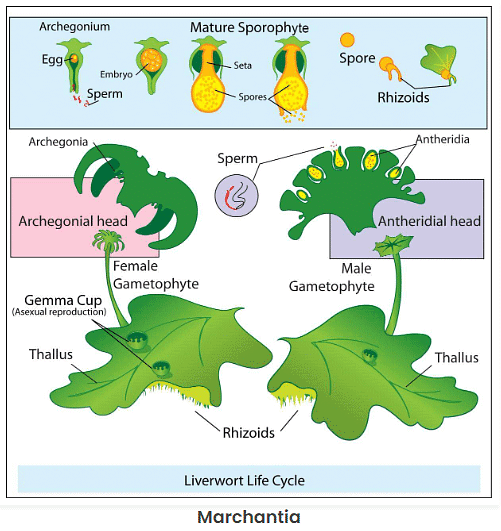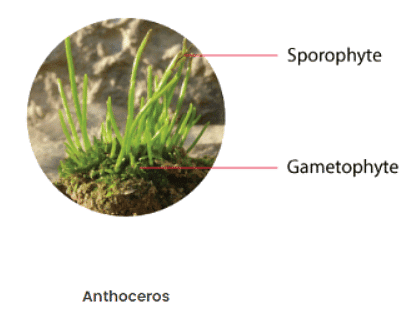Structure and Reproduction Bryophytes | Botany Optional for UPSC PDF Download
Bryophytes
The term "Bryophyta" finds its roots in the Greek words "Bryon," meaning mosses, and "phyton," meaning plants. Bryophyta encompasses embryophytes, which include mosses, hornworts, and liverworts. These are diminutive plants that thrive in shaded and damp locales. Notably, they lack vascular tissues, do not produce flowers or seeds, and instead, reproduce through spores. The scientific study of bryophytes is known as bryology.
Why are bryophytes called amphibians of plants?
Bryophytes are called “amphibians of the plant kingdom” because they are terrestrial plants, but require water to complete their life cycle at the time of sexual reproduction.
Habitat of Bryophytes
- Bryophytes are highly adaptable and can flourish in a wide array of habitats, encompassing varying elevations, temperatures, and moisture levels. They can be found in shady and damp environments, thriving even in extreme and diverse locales such as arctic and desert regions. A remarkable feature of bryophytes is their ability to grow where vascularized plants cannot, as they do not rely on roots for nutrient uptake from the soil.
- Some bryophytes exhibit astonishing resilience, enduring lengthy periods of freezing and arid conditions. Upon the return of moisture, photosynthesis recommences. Additionally, several bryophytes flourish on the persistent remains of their own growth, on soil, or on decaying or living matter from other plants. Some even thrive on the bare surfaces of rocks, while others lead aquatic lives. To prosper, bryophytes necessitate a relatively stable substrate for attachment, a medium that retains moisture for extended periods, appropriate temperatures, adequate sunlight, and a humid environment.
General Characteristics of Bryophytes
Bryophytes possess several distinctive characteristics that set them apart from other plant groups:
- They predominantly occur in damp and shaded areas.
- The plant body is thallus-like, either prostrate or erect.
- Attachment to the substrate is facilitated by rhizoids, which can be unicellular or multicellular.
- True vegetative structures, such as roots, are absent.
- Vascular tissues like xylem and phloem are lacking.
- Bryophytes display alternation of generations, with an independent gametophyte phase that possesses sex organs producing sperm and eggs, and a dependent sporophyte phase containing spores.
- The gametophyte is the dominant phase and is haploid.
- The thalloid gametophyte differentiates into rhizoids, an axis, and leaves.
- Multicellular sex organs are borne on the gametophyte, which is photosynthetic.
- Antheridia produce biflagellated antherozoids, while archegonia resemble flasks and produce a single egg.
- The fusion of antherozoids with eggs forms a zygote.
- The zygote matures into a multicellular sporophyte.
- The sporophyte is semi-parasitic and relies on the gametophyte for nutrition.
- Sporophyte cells undergo meiosis to produce haploid gametes, giving rise to a new gametophyte generation.
- The juvenile gametophyte is referred to as a protonema.
- The sporophyte further differentiates into a foot, seta, and capsule.
Characteristics Of Bryophytes

Classification of Bryophytes
The latest classification system divides Bryophyta into three classes:
A. Hepaticopsida (Liverworts)
The name "Hepaticopsida" is derived from "hepatic," meaning liver. Liverworts belong to this class, which is further subdivided into four orders:
- Marchantiales (e.g., Riccia, Marchantia)
- Sphaerocarpales (e.g., Sphaerocarpos)
- Calobryales (e.g., Calobryum)
- Jungermanniales (e.g., Pellia)
Key characteristics of Hepaticopsida include:
- Gametophyte plants can be either thalloid or foliose.
- In foliose forms, leaves lack midribs and are dorsiventral.
- Thalloid structures are dorsiventral, lobed, and dichotomously branched.
- Thallus cells contain multiple chloroplasts without pyrenoids.
- Rhizoids are unicellular, branched, and aseptate.
- Sex organs are dorsally embedded in gametophytic tissues.
- The sporophyte consists of only a capsule (in Riccia) or a foot, seta, and capsule (in Marchantia).
- The capsule lacks a columella.
- Sporogenous tissues develop from endothecium.
B. Anthocerotopsida (Hornworts)
This class comprises approximately 300 species, commonly known as hornworts, and has a single order, Anthocerotales. Examples include Anthoceros, Megaceros, and Notothylas.
Key features include:
- The gametophytic body is flat, dorsiventral, simple thalloid, and lacks internal differentiation.
- Smooth-walled rhizoids are present.
- Each cell contains one chloroplast with a pyrenoid.
- Sex organs are dorsally embedded in the thallus.
- The sporophyte differentiates into a foot, meristematic zone, and capsule.
- Pseudoelaters are found in the capsule.
- The capsule contains a columella originating from the endothecium.
C. Bryopsida (Mosses)
Bryopsida is the largest class of Bryophyta, encompassing approximately 1400 species, commonly referred to as mosses. Examples include Funaria, Polytrichum, and Sphagnum.
This class is further divided into five orders:
- Bryales
- Andreales
- Sphagnales
- Polytrichales
- Buxbaumiales

Key characteristics of Bryopsida include:
- The gametophyte differentiates into protonema and foliose gametophore.
- Foliose structures consist of a stem (axis) and leaves without midribs.
- Multicellular rhizoids with oblique septa are present.
- Sex organs are borne apically on the stem.
- Elaters are absent.
- The sporophyte differentiates into a foot, seta, and capsule.
- Sporogenous tissues develop from endothecium.
- The capsule contains a columella, and dehiscence occurs through lid separation.
Examples of Bryophytes
Bryophytes encompass approximately 20,000 plant species and can be broadly categorized into liverworts, mosses, and hornworts.
Some common examples include:
- Liverworts:
- Marchantia
- Riccia
- Pellia
- Porella
- Sphaerocarpos
- Calobryum

- Mosses:
- Funaria
- Polytrichum
- Sphagnum

- Hornworts:
- Anthoceros
- Notothylas
- Megaceros
- Anthoceros

Ecological Importance of Bryophytes
Bryophytes play a crucial role in various ecosystems, demonstrating their ecological significance:
- Mosses and lichens are pioneering organisms that colonize rocks, aiding in the breakdown of rocks to create a suitable environment for higher plants.
- Lichens secrete acids that contribute to soil formation.
- Bryophytes densely cover surfaces, acting as soil binders.
- Mosses are instrumental in bog succession, transforming landscapes from open soil to climax forests.
- Their thick mats provide an ideal substrate for hydrophilic seed germination, fostering the development of mesophytic plants.
- Bryophytes mitigate soil erosion by reducing the impact of rainfall and decreasing runoff.
- They aid in nutrient recycling.
- Certain mosses, in conjunction with algae, can form calcareous (lime) rock-like deposits in calcium bicarbonate-rich water, contributing to rock formation.
Economic Importance of Bryophytes
Beyond their ecological significance, bryophytes hold economic importance in various sectors:
- Medicinal Uses: Sphagnum, known for its high absorbent capacity and antiseptic properties, is utilized in surgical dressings. Marchantia has been used historically to treat pulmonary tuberculosis and liver ailments.
- Research: Mosses and liverworts are valuable in genetic research, contributing to the understanding of plant sex determination.
- Packing Material: Dried mosses serve as excellent packing materials for fragile goods, including glassware and bulbs.
- Food Source: Some mosses provide food for herbaceous mammals, birds, and other animals.
- Indicator Plants: Certain bryophytes can indicate soil acidity or basicity, aiding in soil analysis.
- Seedbeds and Greenhouses: Due to their water retention capacity, bryophytes are used in seedbeds, greenhouses, and nurseries for rooting cuttings and trans-shipment of seedlings.
- Peat Formation: Sphagnum, also known as peat moss, contributes to peat formation, which is used as a fuel source and has applications in various industries.
- Stone Formation: Certain mosses, along with algae, participate in the formation of travertine rock deposits, used as a building material.
In conclusion, bryophytes, often referred to as the "amphibians of the plant kingdom" due to their dependence on water for sexual reproduction, play multifaceted roles in the natural world, ranging from ecological to economic significance. Their adaptability and unique characteristics make them a fascinating group of plants that continue to intrigue scientists and benefit various industries.
|
179 videos|140 docs
|

|
Explore Courses for UPSC exam
|

|
















